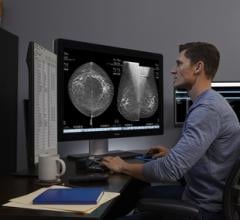
A combination of digital mammography and tomosynthesis detects 90 percent more breast cancers than digital mammography alone, according to a study appearing online in the journal Radiology.[1]
Digital breast tomosynthesis (DBT) is an imaging technology that uses a series of low-dose mammographic exposures to provide a 3-D reconstruction of the breast. In studies comparing both technologies on the same women, DBT has proven to be more sensitive than digital mammography in detecting cancers. Despite DBT's superior sensitivity, some groups caution that it could detect cancers that will never be clinically relevant -- a phenomenon known as overdiagnosis.
To learn more about DBT's impact on sensitivity and recall rate, or the rate at which women are called back for additional screening based on suspicious results, researchers compared results between 9,777 women randomized to undergo digital mammography and DBT and 9,783 randomized to have digital mammography alone.
The combination of digital mammography and DBT detected 8.6 cancers per 1,000 cases, a rate almost twice that of the 4.5 per 1,000 detected by mammography alone. The recall rate was 3.5 percent in both groups. DBT alone detected 72 of 80 cancers found in the DBT and digital mammography group. The greater detection rate for combined digital mammography and DBT was notable for small and medium invasive cancers, but not for large ones.
"Tomosynthesis and digital mammography is much more sensitive than digital mammography," said the study's principal investigator, Pierpaolo Pattacini, M.D., radiologist and director of the Radiology Department at AUSL Reggio Emilia in Reggio Emilia, Italy. "The vast majority of the advantage is due to tomosynthesis alone."
While DBT's higher sensitivity would seem to make it a logical choice for breast cancer screening programs, coauthor Paolo Giorgi Rossi, Ph.D., director of the Epidemiology Unit at AUSL Reggio Emilia said that more research is needed to weigh the benefits of improvements in prognosis and reductions in breast cancer-related mortality from DBT against any undesired effects.
"If these small cancers would never become life-threatening, then we are increasing overdiagnosis and not impacting mortality," he said. "Thus, we need to have a measure of the impact of this higher detection rate on the incidence of advanced cancers and interval cancers in the following years."
The additional reading time DBT would require from breast imagers is another aspect of the technology that requires consideration, according to Rossi.
"For publicly-funded screening programs, this increased reading time would be a big issue, destroying their sustainability," he said. "Implementing tomosynthesis in public screening programs would require rethinking protocols and reading technologies to reduce or eliminate the extra costs."
The new research represents a preliminary analysis from the Reggio Emilia Tomosynthesis trial (RETomo), a larger study in which researchers will be looking at interval cancers, or those detected between screening exams, and cumulative incidence of advanced cancers. To have more precise and reliable estimates of these outcomes, the researchers are promoting a network of ongoing trials on tomosynthesis with similar study design across Europe.
"Once we have this evidence, the consequences for screening could be even larger than a simple shift from digital mammography to tomosynthesis," Rossi said. "For example, it could be appropriate to adopt longer intervals between screenings."
Reference:


 December 16, 2025
December 16, 2025 









